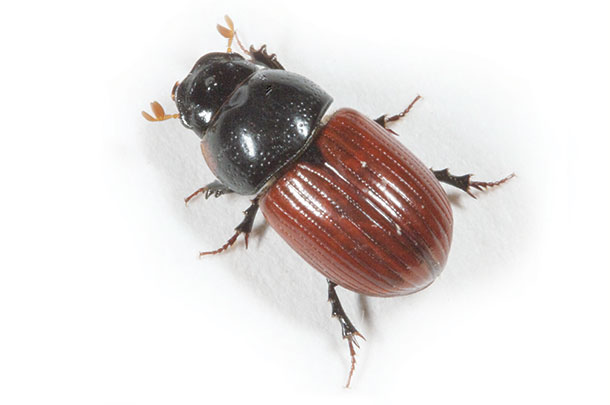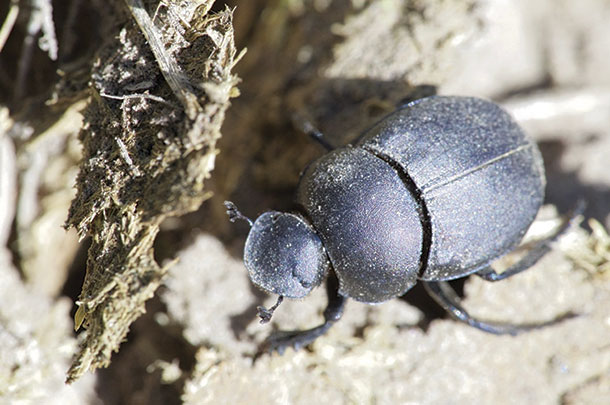With well over 90 species in the U.S., these fascinating insects feed on fresh manure, which also provides the perfect nesting environment for their eggs and larvae. These beetles reduce pesky horn fly populations and improve soil structure.
The largest dung beetles run 2.5 inches long, while the smallest are .1 inch. Their formidable front legs, armed with serrated edges, are perfect for digging. Depending on the species, they are black, red or brown, some with metallic tones. Easily able to detect the odor of dung with specialized antennae, beetles fly up to 10 miles to investigate a fresh cowpat.
Some beetles are active during the day, while others are nocturnal. Dung beetles may be generalists or species-specific, preferring particular animal droppings, such as horses, cattle or deer. Some species ride next to an animal’s tail, in anticipation of fresh droppings. The adults feed on fresh cow patties, then lay eggs.
Matt Bertone, an entomologist at North Carolina State University Plant Disease and Insect Clinic, reports there are three functional types of dung beetles: tunnelers, rollers and dwellers. He says that because of their numbers and their digging abilities, tunnelers are usually the most important for breaking down cowpats.
“The rollers are good when in abundance because they chop up the dung pat, roll it away and bury it,” Bertone explains. “They’re not as abundant as tunnelers, which will come in, drag the dung underground, and bury it right below the dung pat.
The dwellers are the fairly common, smaller ones, so they don’t consume or use as much of the dung pat as the tunnelers, which are larger. All of them contribute to degradation of the dung pat.”
Tim Steffens, an assistant professor of rangeland resource management at West Texas A&M University, reports that in the 1970s, native beetles lagged behind in manure removal. Georgia scientists and the USDA introduced new dung beetle species from Africa.
The goal was to control horn fly larvae, but this tactic also reduces stomach worm larvae. Dung beetle activity causes the cowpat to disintegrate, causing a hostile environment for fly and parasitic worm larvae, which dry out and die.

Pastures and rangeland also benefit from beetles, because they bury manure immediately, which leads to nutrient cycling, especially in areas with more rainfall. Steffens says some producers have eliminated fertilizing pastures because dung beetles bury all the droppings quickly, resulting in a closed cycle. During the right conditions, dung beetles completely recycle manure in as little as 36 hours after cattle move to a new pasture.
By cleaning the pasture, more grass is accessible to livestock and grass does not smother under piles of manure. The beetles’ digging turns and aerates the soil, which captures available rainwater.
Promoting healthy quantities of dung beetles
Steffens advises producers to “keep enough cover so the ground stays moist. They can bury things [easier], and it also helps keep the forage quality high because high-quality forage makes high-quality dung. High-quality dung is a better food source ... and makes better places to put their eggs.”
Not only do these insects prefer moist earth, but some soils are simply easier for them to dig in, such as sandy and loam. Areas of dense clay are not as “user-friendly” for dung beetles. Although these insects may be present all year long in warm, southern states, those in colder climates are active only during warmer spring, summer and fall weather.
Cattle raisers may determine if they have a population of dung beetles by looking for the ball rollers. After the female lays eggs in a ball of manure, she and the male roll the brood ball away from the cow pie to bury it. They then return to the cowpat to repeat the process.
Bertone recommends using a shovel to scrape off the top of a cowpat when it is dry enough to handle. Look for holes or live dung beetles. Turn over the dung pat to see if there are holes with dirt mixed in. Those are indications of dung beetle activity.
“If that dung pie is getting broken up into little pieces before it dries out, that’s a really good sign,” Steffens advises. “If there’s no little holes on the underside of it, things are pretty dead.”
Bertone suggests producers check beetle populations by placing dung in a bucket of water. Dung beetles tend to move to the surface, where they can be scooped up, examined and released. Another approach is to place dung in a plastic cup. Bury it in the ground, level with the surface. After three to four hours, remove the cup from the earth to check for dung beetles.
Declining populations
Jeffrey Bradshaw, an associate professor of entomology and extension specialist with the University of Nebraska – Lincoln, reports that dung beetle populations appear to have declined in many areas of the U.S. In fact, several publications have written about dewormers and insecticides used on cattle, and the resulting impact on dung beetle populations.
There appears to be no clear-cut conclusion about this controversial topic regarding products that may harm dung beetle larvae.

While there have been studies in controlled laboratory settings, additional examination of the sublethal effects of dewormers and insecticides are needed. They appear to reduce weight gain in dung beetle larvae, which increases the time it takes them to develop.
“Some grazing strategies generally conserve diversity and abundance [of dung beetles],” Bradshaw explains. “We looked at a continuous grazing system with a couple of different rotational grazing strategies.
Once on. Twice on. Then we had high-density grazing over a small area with a high rotation rate. It didn’t matter what type of rotation grazing – it seemed that having some rotation as part of the practice increased diversity and abundance [of dung beetles].”
Steffens also observes that a regular grazing rotation system is good for cattle and beetles.
“[There is a] regular recovery for the grazed plants to regrow between grazing periods,” Steffens explains. “Doing that also tends to concentrate the manure on a smaller area at a time, and livestock move away from parasite infestations before they become infective.
If the recovery period is long enough for the grass to regrow sufficiently, the parasites are normally dead or buried by the dung beetles before livestock return.”
Other scenarios that may promote dung beetle diversity and population include:
- Test cattle to determine if they have internal parasites before applying dewormers and insecticides.
- Treat cattle with dewormers during the cold months, before beetles and their larvae are active.
- Provide back rubbers, eartags and the prudent use of insecticides that have little or no effect on dung beetles.
- Consider flytraps.
“The promise and the hope is that [ranchers] might be able to engage in practices that conserve [beetle] numbers, because they do perform an essential function on rangeland,” Bradshaw says. “Not just for recycling the dung pat, but processing the dung pat, lysing [breaking up] eggs and removing the source of horn fly breeding habitat. [These] are all good things.”
PHOTO 1: Rainbow scarab – This iridescent rainbow scarab is a flashy “tunneler.”
PHOTO 2: Aphodius fimetarius – This is a common dung “dweller” that was accidentally imported from Europe and is now widely distributed in the U.S.
PHOTO 3: Common tumblebug – This common roller is a fine example of a tumblebug. Check out the powerful front legs, which are perfect for digging. Photos provided by Jeff Bradshaw, Nebraska Extension.







